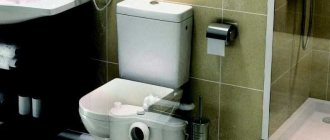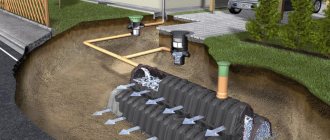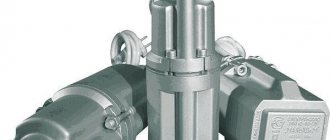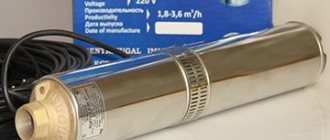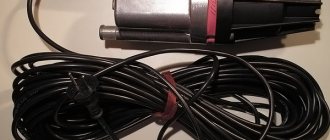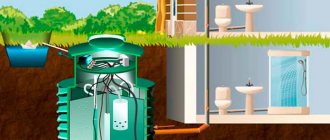The main stage in creating a pressure drainage system is the installation of a sewage pump. The correct selection and installation of this device guarantees stable and efficient operation of the section of the system that supplies waste from lower levels to higher ones.
Pressure sections of the sewer system allow you to organize drainage in case of poor terrain or placement of plumbing fixtures below the sewer pipes. Also used for negative pipeline slopes. The transfer of wastewater under pressure is carried out in domestic and industrial systems. Let's take a closer look at this issue.
When is it necessary to install a kitchen pump?
If, for some reason, it is not possible to place the sink next to the riser, then the wastewater will drain away quite slowly on its own. Taking into account the fact that the composition often includes solid waste and fatty particles, after some time of operation the movement slows down even more or stops completely.
The main reason for this situation is the narrowing of the working space of the pipeline due to the deposition of fatty deposits and the formation of solid residue on the walls of the pipes. The result of this is the need for frequent sewer cleaning - see how to do hydrodynamic sewer cleaning yourself. A stench may begin to spread in the apartment and kitchen, in particular.
To avoid this situation, you can redesign the room and place the sink closer to the riser, but this is quite a troublesome and costly task. It is better to go with the second option - use auxiliary tools, for example, install a sewer pump for the kitchen.
The equipment will forcefully push waste liquids into the sewer system, this will prevent the formation of a fatty layer and deposits inside the pipe.
Also, after installing the system, it is possible to connect a washing machine and dishwasher to it. Using a sanitary pump will allow you to remove all waste liquids at the same time much faster.
However, this device can be installed not only in the kitchen, but also in the bathroom. In this room, waste liquid is removed from the washbasin, shower/bathtub, and toilet. In the latter case, the water additionally contains solid waste, so often a grinder pump is installed for the entire room.
Design and principle of operation
Sewage pumps for the kitchen are in most cases quite similar, the main differences lie in the functionality of the device. For example, many types of equipment differ in the presence or absence of the ability to grind solid waste.
Kitchen models in the high price category most often have a similar function. It can significantly reduce the likelihood of pipeline clogging.
The design of a sewage pump for a kitchen in most cases has the following elements:
- sealed housing (usually hard plastic) with a water reservoir;
- a membrane valve that activates and stops the system;
- electric motor with automated start function;
- holes for the entry and exit of various communications, they can be located horizontally or vertically;
- ventilation filtration valve, which prevents unpleasant odors from arising in the room and spreading throughout the house.
High quality equipment usually does not require serious maintenance. It is enough to occasionally rinse the tank and change or clean the filter. A sewage pump for a kitchen with a chopper also implies the presence of chopper knives in the design.
Operating principle: wastewater from plumbing fixtures enters a special tank. When the volume reaches a certain value, the diaphragm valve is activated and the electric motor turns on automatically. The waste is crushed and the liquid is forced to be transferred into sewer pipes. Then the level of waste water decreases, which leads to the cessation of operation of the device.
Shredder installation
There are no difficulties in installing a sanitary pump for a toilet; even a beginner can handle it. Sequence of work:
- Pipeline installation. In order to make a connection to a gravity sewer, you can use any pipes, it is important that the range corresponds to the power indicators of the unit. Another important point: you need to avoid right angles when installing pipes, as they can make it difficult to “push” the drains. Otherwise, complete freedom: pipe diameter, material, etc. Work order:
- Laying a sewer pipe.
- Insertion into a gravity sewer.
- Connection to the waste pipe of the chopper outlet.
- Connection to the toilet. The chopper is connected to it using a corrugated pipe. The wastewater will flow into it by gravity, in order to avoid any difficulties with this, the following requirements must be met:
- The toilet outlet should be higher than the grinder inlet.
- There should be no deflections in the corrugation.
- The rotation of the corrugation should not be at a large angle.
In order for the pump with the chopper to function, all that remains is to connect it to the electrical network.
Types of pumping equipment for the kitchen
There are several types of devices, depending on the tasks performed. All models pump out wastewater, but in different cases it is more effective to use different types of equipment. They are divided into the following types:
- sanitary;
- stationary;
- pumping stations.
Sanitary models are considered the easiest to install; they have low power and in most cases are mounted under the sink. As a rule, they do not have chopping knives in their design. The temperature of the waste liquid cannot exceed 40 degrees; such models are capable of draining wastewater from only one unit of plumbing fixtures.
Connecting a washing machine and dishwasher will not work. The advantage of this type is its small size, ease of installation and dismantling, and low energy consumption. Such a sewage pump is often installed in small apartments.
The stationary version in most cases is connected to several devices at once and is installed away from all plumbing. Such devices are suitable for treating hot water (up to 75 degrees) and have greater power. As a rule, they are equipped with grinding elements.
Domestic sewerage stations have the greatest capacity. The maximum vertical movement is approximately 10 meters, horizontal movement can reach 100 m. Such models are rarely installed in apartments, most often they are installed in country dachas and cottages. Adapted to high water temperatures, can work continuously for a long time.
Key Features
When choosing a pump with a grinder for domestic use, you need to pay attention to the following characteristics:
- Transportation distance. When choosing this indicator, it is necessary to focus on the remoteness of the gravity sewer, and based on this, select the power. The average toilet grinder pump can transfer waste water over a distance of 70 to 100 meters horizontally or 7-10 meters vertically. Often this is enough.
- Additional connections. The possibility of combined connection will be a plus.
Advice from an expert! If there are many appliances in the bathroom that need to be connected to the pump, it is worth dividing them into groups: for hot clean drains (bathtub, washbasin, washing machine) and dirty cold ones (toilet). It is worth buying separate devices for two groups.
- Fluid temperature. Standard values are 40-90 degrees. If you plan to connect only to the toilet, then you can get by with a device with a minimum temperature. Connecting a washbasin or shower/bathtub requires pumps with a higher operating temperature.
Popular pump models
Before installing a sewerage pump in an apartment for the kitchen, it is recommended that you first familiarize yourself with the features of all the proposed options. The most popular models are:
- Grundfos Sololift2 C3. They do not have a grinding component, but are able to withstand the temperature of the waste liquid up to 90 degrees and work with several sanitary appliances at once.
- SFA Sanivite Silence. The main advantage of this model of sewage pump for the kitchen is the use of high-quality soundproofing materials in the design. As a result, the noise level from the operating device is significantly lower compared to other options. They lift liquids up to 5 meters in a vertical position and up to 50 meters in a horizontal position.
- SFA Sanispeed. They are distinguished by increased power and are often used in large houses with several bathrooms. They can pump wastewater through small cross-section pipelines (32-50 mm).
- Unipump Sanivort 250. They have a long service life; these kitchen sewer pumps are often installed in small apartments. They are practical, their body is quite easy to clean.
- SFA Saniaccess Pump. They do not have cutting elements in their design. These models are designed for situations where you need to place a bathroom or kitchen far from the sewer riser. Adapted to short-term liquid temperatures up to 75 degrees.
Recommendations for installing a kitchen pump
Despite the fact that in most cases installation is carried out by a specialist, if you have the necessary knowledge, you can do it yourself.
Watch the video
Before starting the procedure, it is recommended to study certain subtleties:
- You can install a sewer pump in the kitchen anywhere in the apartment. Most often, this is done in special niches, placed under the sink or in completely open places. However, it should be taken into account that the drains move independently before the pump, so it is advisable to install the pipes at a certain angle (about 2-4 cm per 1 meter) or in a vertical position.
- The use of supply pipes that are too long should be avoided, as otherwise, you may need to install multiple septic pumps for your kitchen.
- The efficiency of the device depends on the size of the outlet.
- It is strongly not recommended to connect multiple pumps to the same network. It is necessary that each pump has its own outlet to the pipeline.
- If the outlet pipe is long enough and is located below the level of the pumping equipment, then it is recommended to install an air valve to air the pipeline.
- The pump runs on electricity, so the power connection must be made via a separate dedicated line. If the equipment includes a cord and plug, the socket will need to be mounted from the panel and the residual current device (30 mA).
- Supply pump pipes cannot be cast iron or corrugated models; it is advisable to use only high-strength polypropylene pipes.
- If you plan to use only one sewer pump for the kitchen and additionally connect a dishwasher/washing machine there, then it is important to make sure that the selected equipment is capable of working with several plumbing fixtures. It is also important to find out before installation what the maximum permissible temperature of waste liquids is.
How to connect the pump to the sink
Watch the video
To ensure the installation procedure goes smoothly, it is recommended to follow the instructions exactly. Algorithm of actions:
- Disconnect the supply pipe from the sink.
- It is required to install the mounting bracket from the pump equipment kit onto the rubber gasket.
- Using polypropylene supply pipes, it is necessary to connect the sink drain to the body of the installed sewage pump.
- On the other side of the housing, connect to the outlet of the centralized sewerage system using plastic pipes.
- Connect the device to the power supply.
How to choose pumping equipment
In order for the device to function correctly over a long period, it is necessary not only to carry out high-quality installation, but also to select the most suitable model in a particular situation.
When choosing a model, it is recommended to adhere to certain rules:
First of all, it is advisable to clarify the power and capacity of the tank of the selected model. It is important that the equipment fully copes with the volume of waste liquid. The optimal value is considered to be 25 cubic meters. m. per hour for a family of 4-6 people;- determine the appropriate pipe diameter; this depends, for example, on the cross-section of the sewer riser and the nature of the drains. The most popular are kitchen pumps with a diameter of 80 mm;
- take into account the degree of adaptation to hot water. This is especially true for situations where apartment owners plan to connect several appliances to one pump at once, including washing machines and dishwashers. When hot water is supplied to a pump designed for cold liquid, it will quickly stop working correctly;
- It is advisable to purchase equipment with a built-in thermal fuse. It automatically turns off the pump when water is supplied at elevated temperatures;
- You should pay attention to the method of connecting the outlet pipes to the body. If there are vertical pipes, the problem does not arise; installation of this model is quite simple. And if the connection is made horizontally, then an additional adapter pipe will be required.
Watch the video
Features of pressure sewerage
A sewer system that uses pumps that force wastewater is called a pressure sewer system.
For assembly, special pipes are taken, since when the equipment operates, pressure is created inside which must be dealt with. Of course, it is far from the same as in water pipes, but the load for simple pipelines is large, and they leak under it.
Pressure sewerage has advantages and disadvantages.
Pressure sewer system
Advantages:
- Thanks to artificial current, it is possible to install pipes of smaller diameter. On the same riser, it is allowed to use a pipe with a diameter of 150 mm in accordance with SP 32.13330.2012, if the pipe is installed for general drainage of wastewater, that is, domestic wastewater is discharged into the sewer together with storm water. For a gravity system, it is recommended to use large pipes.
- The length of sewer pipes can be increased. Gravity systems are not always able to cover the required distance, since it is necessary to maintain the slope level.
- The pressure sewer gets clogged much less often, since due to the pressure created inside, the solid parts of the drain cannot catch on anything.
- Household and sanitary appliances can be installed in any convenient place, since there is no connection to the slope of the terrain and pipes.
The structure of a fecal pump for a private house.
The disadvantages are as follows:
- A complex sewerage system, including reinforced pipes and other technological components, for example, an intermediate storage tank. This indicates greater installation complexity and high price.
- Installation of a sewage pump requires connection to an electrical network - not critical, but worth considering. This is an additional waste of money and effort.
- If the pumping equipment fails, the house is left without sewerage, especially if the system does not provide an intermediate storage tank.
A special shape of the pipe socket for pressure sewerage
